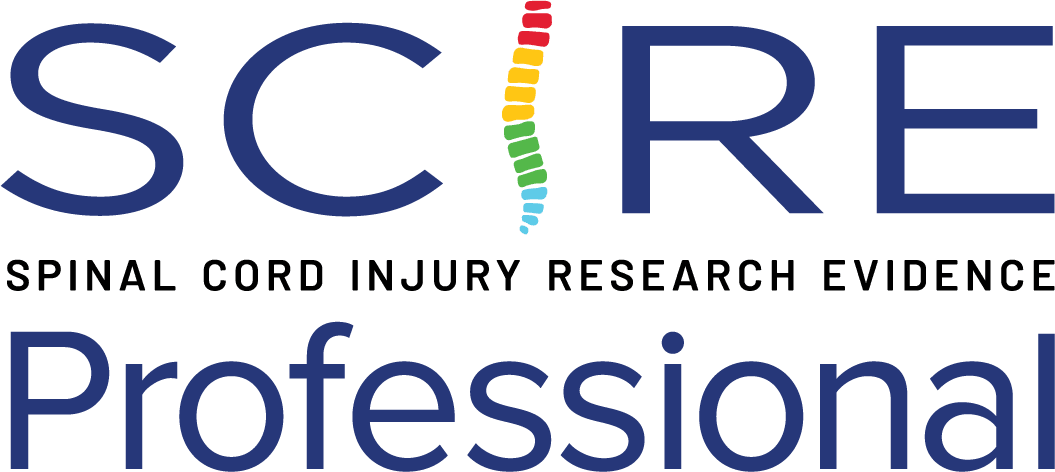- The Neuromuscular Recovery Scale (NRS) was developed by physical therapists and scientists within the Christopher and Dana Reeve Foundation NeuroRecovery Network (NRN).
- The aim is to measure the quality of movement in a safe environment (a body weight support system and a treadmill are used) without compensatory movement patterns (Behrman et al. 2015).
- The NRS includes 11 items and classifies motor function into 4 phases, with higher phases indicating a greater return of movement. Up to 3 subphases (a-c) per phase (phase 4 has no subphases) capture incremental changes within each task.
Clinical Considerations
The reference for comparison is typical preinjury movement patterns during task performance.
ICF Domain
Activity ▶ Mobility
Administration
The testing should begin with the first of the overground items, sit, continue through the overground items, and then follow with the items in the body weight support treadmill environment.
Length
30-50 minutes
Number of Items
- 11 items:
- Sit
- Reverse sit-up
- Sit-up
- Trunk extension
- Sit to stand
- Stand
- Walk
- Stand retraining
- Stand adaptability
- Step retraining
- Step adaptability
- 4 phases:
- Phase 1 represents the greatest impairment relative to normal movement patterns, with most people being nonambulatory and sitting being the goal.
- In phase 2, people begin to stand and weight support independently with associated proper kinematics.
- At phase 3, walking begins with several steps to continuous stepping.
- Phase 4 reflects normal locomotor performance with marked adaptability to varying conditions and return to recreational activities (e.g., running).
- Subphases:
- Phases 1-3 have 3 subphases (a-c); phase 4 has no subphases.
Equipment
- Treadmill
- Body-weight supported system
- Four personnel
Scoring
- Each of the items represents a hierarchy of performance capacity from the lowest level (scored 1A) to a high level of capacity (scored 4).
- The examiner then calculates the overall phase based on the combined phase scores of each of the individual items.
Languages
English.
Training Required
No formal training required. However, training to a level of competency in its use is recommended.
Availability
Can be found in the appendix of the following articles:
Check http://neurorecoverylearning.org/ for further information, courses, and the cost of equipment.
Measurement Property Summary
# of studies reporting psychometric properties: 4
Interpretability
The continuum of scores proceeds from unable to complete the task to achieving full recovery by executing the tasks as done preinjury.
MCID: not established in SCI
SEM: not established in SCI
MDC: not established in SCI
Reliability – High
- Test-retest reliability is high (ρ = 0.99).
(Behrman et al. 2015; n=69; 56 males, 12 females; mean age 36 years; complete and incomplete SCI (ASIA A-D); injury level: 46 cervical, 23 thoracic; mean time since injury 3.3 years)
- Inter-rater reliability is high (ICC = 0.96) (W = 0.91 – 0.98).
(Behrman et al. 2019; Pediatric NRS; n=32; 17 males, 15 females; mean age 6 years, incomplete and complete SCI (ASIA A-D); injury level: 12 tetraplegia, 12 paraplegia)
(Basso et al. 2015; n=10; 7 males, 3 females; mean age 43 years; complete and incomplete SCI (ASIA A-D); level of injury: 8 cervical, 2 thoracic; mean time since injury 26 months)
Validity – Not Rated
- The Principal Components Analysis (PCA) revealed that the Rasch measurement dimension explained 76.9% of the variance. Ten of 11 items and 91% of the patients fit the Rasch model, with 9 of 11 items showing high discrimination. Sixty-nine percent of the ratings met criteria.
(Velozo et al. 2015; n=188; 141 males, 41 females; mean age 39.3 years, complete and incomplete SCI (ASIA A-D); injury level: 132 cervical, 53 thoracic, 3 lumbar; mean time since injury 1.2 years)
Responsiveness
- Adjusted response mean = 1.05; CI = 0.75-1.35).
- The scale was also significantly responsive for the different SCI subgroups; it was higher for individuals classified as AIS C or D (ARM = 1.53 [1.13, 1.96]) compared with individuals classified as AIS A or B (ARM = 0.64 [0.22, 1.05]).
(Tester et al. 2015; n = 72, 57 males, 15 females, mean age 36 years, mean time since injury = 0.7 years)
Floor/Ceiling Effect
- Does not have floor or ceiling effects.
(Velozo et al. 2015; n=188; 141 males, 41 females; mean age 39.3 years, complete and incomplete SCI (ASIA A-D); injury level: 132 cervical, 53 thoracic, 3 lumbar; mean time since injury 1.2 years)
Reviewers
Dr. Carlos L. Cano-Herrera, Matthew Querée
Date Last Updated
31 December 2024
Basso DM, Velozo C, Lorenz D, Suter S, Behrman AL. Interrater reliability of the Neuromuscular Recovery Scale for spinal cord injury. Arch Phys Med Rehabil. 2015; 96: 1397-403. doi: 10.1016/j.apmr.2014.11.026.
https://pubmed.ncbi.nlm.nih.gov/25546720/
Behrman AL, Velozo C, Suter S, Lorenz D, Basso DM. Test-retest reliability of the Neuromuscular Recovery Scale. Arch Phys Med Rehabil. 2015; 96: 1375-84. doi: 10.1016/j.apmr.2015.03.022.
https://pubmed.ncbi.nlm.nih.gov/25883038/
Tester NJ, Lorenz DJ, Suter SP, Buehner JJ, Falanga D, Watson E, Velozo CA, Behrman AL, Michele Basso D. Responsiveness of the Neuromuscular Recovery Scale During Outpatient Activity-Dependent Rehabilitation for Spinal Cord Injury. Neurorehabil Neural Repair. 2016; 30: 528-38. doi: 10.1177/1545968315605181.
https://pubmed.ncbi.nlm.nih.gov/26359344/
Velozo C, Moorhouse M, Ardolino E, Lorenz D, Suter S, Basso DM, Behrman AL. Validity of the Neuromuscular Recovery Scale: a measurement model approach. Arch Phys Med Rehabil. 2015; 96: 1385-96. doi: 10.1016/j.apmr.2015.04.004.
https://pubmed.ncbi.nlm.nih.gov/25912666/
